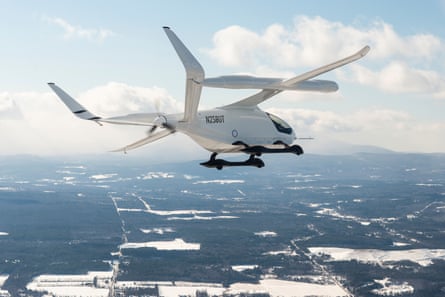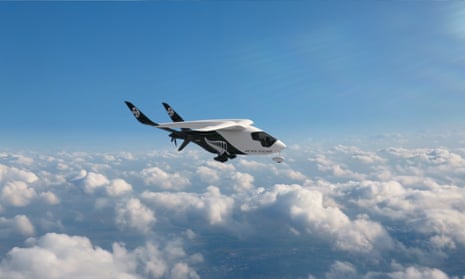Parcels and letters will soon be distributed by electric aircraft between regions of New Zealand as the sparsely populated country embarks on a “new age of propulsion” in its attempts to decarbonise its reliance on aviation.
On Wednesday, Air New Zealand announced it had purchased a battery-powered, all-electric five seater cargo aircraft, which will be put to use running mail between airports with New Zealand’s postal service from 2026.
The next-generation ALIA aircraft, designed by US aero firm Beta Technologies, will take off and land like a conventional airplane. The roughly 12 metre-long aircraft weighs three tonnes and can reach speeds of up to 270km an hour, meaning it will likely travel slower than conventional aircraft. It will be able to carry up to 560kg of cargo.
Much like electric cars, the futuristic aircraft also comes with range anxiety. While it can fly more than 480km, it is only expected to be flown on routes of about 150km domestically in New Zealand. Recharging its battery from empty will take between 40-60 minutes, slightly longer than refuelling a similar sized traditional aircraft.
The airline will now determine which routes on which it will run the initial flights, as it will need to install specialist charging cubes at airports to recharge the aircraft between runs.
Air New Zealand’s purchase is the first in its mission to bring next-generation aircraft into its fleet. It also has options for an additional two of the ALIA aircraft and rights for a further 20 under the deal with Beta.
The airline is considering zero-emissions aircraft options from three other companies, including smaller passenger aircraft, which it has been evaluating since last year.
Greg Foran, Air New Zealand’s chief executive, told the Guardian he hopes the airline will be running zero-emissions electric flights carrying passengers by 2030. “With cargo, it becomes a bit easier. And as we get really good at that, then you say all right, well, it’s worked out, what happens if we put some passengers on?”
Foran said New Zealand’s geography and the distances and passenger loads on his airline’s existing network meant the carrier was a logical frontrunner in electric passenger aviation.

“In the case of electric aircraft, there’s some physics at play that say, batteries weigh x and electric motors can have an output of y, so you can only make these things so big and they can only travel a certain distance,” Foran said. “You sort of begin smaller and then you work out how to make them bigger as opposed to the other way around.”
Foran acknowledged that current technology means electric-run aircraft can only realistically replace the smallest planes in its fleet and that a mix of approaches will be needed to reduce its emissions.
While Air New Zealand operates smaller capacity turboprop planes on its shorter domestic routes, it also operates widebody jets internationally, and Foran acknowledged sustainable aviation fuel (SAF) would also be crucial for the airline to decarbonise.
Foran said that being an early adopter of electric aircraft meant that Air New Zealand could familiarise itself with the regulatory, safety and maintenance aspects of electric aviation ahead of competitors.
“What you’re starting to see is … a new age of propulsion in the year; it’s been a long time since the jet engine has been challenged,” he said.
“We want to get on this journey and start to learn as quickly as we can … How do you turn it? How long does it take to recharge what happens when this doesn’t work, or that doesn’t work? The best way to learn these things is actually to begin.”
Air New Zealand’s announcement comes as Australia’s aviation sector grapples with the challenge of meeting ambitious climate targets. The country is dependent on long-haul international flights for global connectivity, while its regional and remote communities rely on air connections to access economic and health benefits in the cities.
Australian regional carrier Rex Airlines took a stake in Dovetail Electric Aviation earlier this year, and is hoping to trial flights next year using a hydrogen fuel cell system to power a small, zero-emission aircraft that could one day replace the airline’s ageing fleet of 36 seater Saab 340 turboprop planes that are no longer in production.
Meanwhile, there are concerns the lack of availability of SAF in Australia and the Pacific could pose connectivity issues in the future.
Virgin Australia has already flagged changes to Australia’s emissions reductions laws so carriers can buy greener fuel to power other airlines’ planes overseas but be recognised as if it had used the fuel on its domestic flights.
